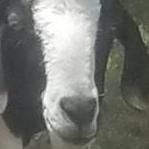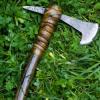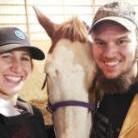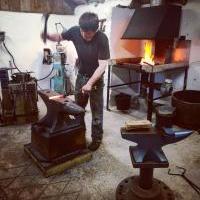-
Posts
86 -
Joined
-
Last visited
Profile Information
-
Gender
Male
-
Location
Kolam, Kerala, India
-
Interests
Growing vegetables, beekeeping, seed saving, blacksmithing.
Recent Profile Visitors
1,947 profile views
-
Daswulf Cool thanks for the feedback on them. You are right and did just that on the bottom half of the tongs. Might not be obvious from the picture. The reason I am looking for some feedback is because they are my second set and need to find out if proportions are right. Well and we all love showing off a little from time to time. But from what you guys are saying they are alright. Will keep making them like that. One thing that had me stumped was the length of the rivet. Mine was to long at first and I had to grind the mushrooming sides away. Any tips welcome. ThomasPowers, ha yes let me know where your local flee market is. But honestly am a wee bit attached to them now after all the work :).
-
Thanks guys, Rains could have been a wee bit longer, they are 14 inches long and hold strongly. I had cut the ends off estimating them to be what I needed. Was trying to get the ends into the forge as the force from the hammer blows kept bending the boss area. It is quite thick, but at orange heat. Could not quench the boss as I think the rods I used are made from high carbon steel and may shatter when quenched. Got lucky and found an anvil from a JCB chisel that is on edge. But it really does make a difference having anvils on edge if the face is good.
-
Alright so made these now over the last few days. They are made from some 3/4 inch high tensile studs. Never doing that again by hand. Is there a specific name for them? Maybe v grove tongs. Also do feel free to let me know what could be improved. Cool with that. Cheers David. Hope it is alright to upload several pics as I wanted to show the steps I had to do to get them done.
-
First of thanks guys for all the helpful info. Hi Iron Poet would it be alright if you explain the demarcation a little further. Did hit the "axe" and it made a great thud Better luck next time. Cool flower BTW. Hi lyuv, Just to see if I got you right, the previously cleaned edge stays more or less in the same plane without one metal moving beyond the edge of the other.
-
Was gona make a hatched for August, but that will have to wait now for next month, as my forge welding attempt to make one failed. So instead thought of punching the eye instead and so needed to make a simple punch. The tip is slightly wider and thicker and tapers two inches towards he striking end. First time I did some tempering too. Was a lot of fun.
-
Thanks FoxFire, Makes a lot of sense. Just to update the weld actually came apart on me when I tried to drift the eye wider. Did it at a red heat. In the bottom photo of my first post it is the weld bellow. It was interesting that it was the underside when I did the welds, so turning the billet is important. You live and you learn. Dropping the darn thing and as I recently found out, not removing the scale with a wire brush at orange heat was a mistake too. Well never mind will keep at it.
-
Been googling this question now for the past hour and can not get a proper answer. Also did ask this question on a different thread here on this forum, but it is not related to the original question of that thread and not any wiser. I am wondering how do beginners like me know if our efforts have paid of regarding to doing forge welding and having them hold well enough, to not come apart later on. It is probably obvious that visual cracks will not work, but what about lines in the welds? I have now done three welds in total. They look and feel solid enough but them lines have me worried. First picture is my attempt at damascus (two folds in total), second is my attempt at a hatchet. The hatched has a spring steel insert and as many of you know it is very hard to move under the hand held hammer. Don't want to waist 5 hours of my time if it just comes apart later on. Am not that mad. If anyone could let me know would appreciate it. Also would like to invite people to post some pictures of their failed attempts and what a good weld may look like. I think to have some pics would be good and some detailed info on how to recognize a good from a bad one. Cheers David.
-
I see so you make a taper at the end of the v to create a scarf joint for it to not cut into the spring insert. Al right then as this is just a test on how my weld is doing I will convince myself under those circumstances that it is alright to further draw out the piece and see if that will work. Thanks for getting back to me on it.
-
I think you may be right. Did the weld 5 times with the first two perhaps not being hot enough. Piece kept sliding around. Plus I did drop the piece just before the very first weld and the insert that was up in till that point stuck in there by the bolt clamp thing came out. I used WD40, but as soon as it dropped out I got some boric acid on the piece. On the third it stuck at the back. Then spend the next two trying to close the front bit and hammering on the back as well and think I got some of the front to stick eventually but not all. That is why I ground the front away. I found some gaps that I could see with the naked eye. But to be honest I did not wack the mild steel into the spring steel as I was busy with getting the front welded and it was getting late. So ended up normalizing the piece three times. But what do I know. Thought it might be a good idea. Do you think those very fine lines are OK? They go around the entire weld. You know the dark lines between the welds. Will the weld hold. Am worried as I dropped the piece that I had scale build up from the very first weld and those may be the dark lines?.
-
will52100, What you were trying to say was very clear from the beginning to be honest. Easy to grasp and thanks for making your point. If you have noticed a difference in size once you get up to those numbers then it is reasonable to assume that one can take your word for it. Especially if you have done many such billets. In the back of my mind I will file that info away and at least take it into consideration once I get to that stage. Nothing is written in stone. Depends is usually the word!
-
OK got a wee bit carried away with the grinding First picture is before grinding and cutting of the bolt area the rest is how it looks now. You will notice a very fine line that is around one quarter of the width of a hair, going around the weld area. Is that normal or did I mess up the weld now after all? The front part where the bolt was, needed most of the grinding, as am sure there was a gap between the pieces. This was on both sides. Still need to drift the eye, as it is a bit small, I think I made the insert too long. Am pleased though by what I may still be able to do with it.




